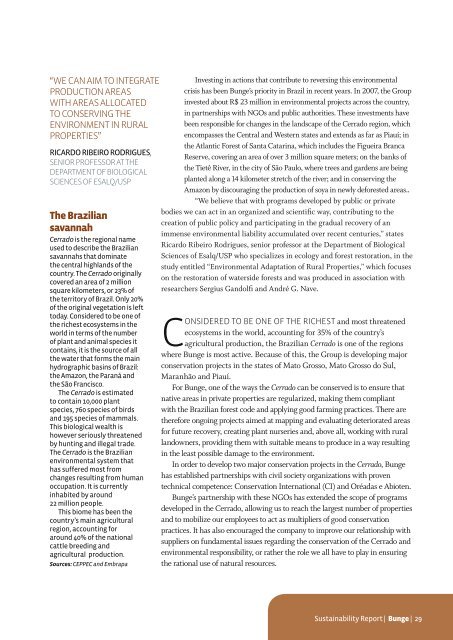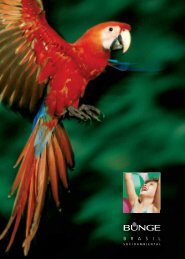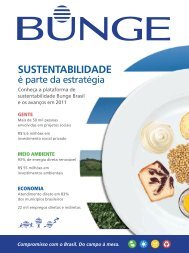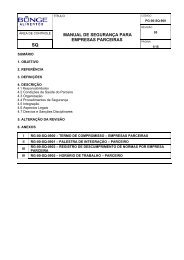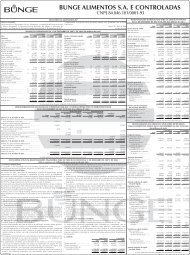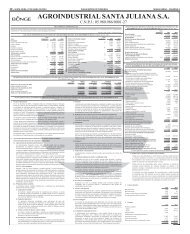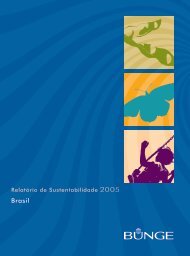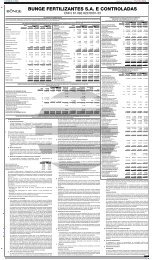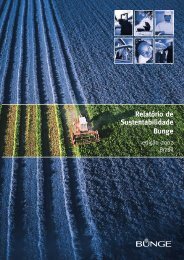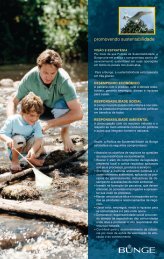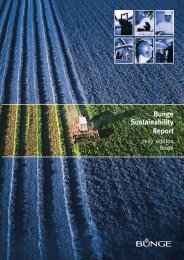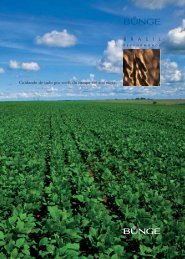SUSTAINABILITY - Bunge
SUSTAINABILITY - Bunge
SUSTAINABILITY - Bunge
Create successful ePaper yourself
Turn your PDF publications into a flip-book with our unique Google optimized e-Paper software.
“WE CAN AIM TO INTEGRATEPRODUCTION AREASWITH AREAS ALLOCATEDTO CONSERVING THEENVIRONMENT IN RURALPROPERTIES”Ricardo Ribeiro Rodrigues,SENIOR PROFESSOR AT THEDEPARTMENT OF BIOLOGICALSCIENCES OF ESALQ/USPThe BraziliansavannahCerrado is the regional nameused to describe the Braziliansavannahs that dominatethe central highlands of thecountry. The Cerrado originallycovered an area of 2 millionsquare kilometers, or 23% ofthe territory of Brazil. Only 20%of the original vegetation is lefttoday. Considered to be one ofthe richest ecosystems in theworld in terms of the numberof plant and animal species itcontains, it is the source of allthe water that forms the mainhydrographic basins of Brazil:the Amazon, the Paraná andthe São Francisco.The Cerrado is estimatedto contain 10,000 plantspecies, 760 species of birdsand 195 species of mammals.This biological wealth ishowever seriously threatenedby hunting and illegal trade.The Cerrado is the Brazilianenvironmental system thathas suffered most fromchanges resulting from humanoccupation. It is currentlyinhabited by around22 million people.This biome has been thecountry’s main agriculturalregion, accounting foraround 40% of the nationalcattle breeding andagricultural production.Sources: CEPPEC and EmbrapaInvesting in actions that contribute to reversing this environmentalcrisis has been <strong>Bunge</strong>’s priority in Brazil in recent years. In 2007, the Groupinvested about R$ 23 million in environmental projects across the country,in partnerships with NGOs and public authorities. These investments havebeen responsible for changes in the landscape of the Cerrado region, whichencompasses the Central and Western states and extends as far as Piauí; inthe Atlantic Forest of Santa Catarina, which includes the Figueira BrancaReserve, covering an area of over 3 million square meters; on the banks ofthe Tietê River, in the city of São Paulo, where trees and gardens are beingplanted along a 14 kilometer stretch of the river; and in conserving theAmazon by discouraging the production of soya in newly deforested areas..“We believe that with programs developed by public or privatebodies we can act in an organized and scientific way, contributing to thecreation of public policy and participating in the gradual recovery of animmense environmental liability accumulated over recent centuries,” statesRicardo Ribeiro Rodrigues, senior professor at the Department of BiologicalSciences of Esalq/USP who specializes in ecology and forest restoration, in thestudy entitled “Environmental Adaptation of Rural Properties,” which focuseson the restoration of waterside forests and was produced in association withresearchers Sergius Gandolfi and André G. Nave.CONSIDERED TO BE ONE OF THE richest and most threatenedecosystems in the world, accounting for 35% of the country’sagricultural production, the Brazilian Cerrado is one of the regionswhere <strong>Bunge</strong> is most active. Because of this, the Group is developing majorconservation projects in the states of Mato Grosso, Mato Grosso do Sul,Maranhão and Piauí.For <strong>Bunge</strong>, one of the ways the Cerrado can be conserved is to ensure thatnative areas in private properties are regularized, making them compliantwith the Brazilian forest code and applying good farming practices. There aretherefore ongoing projects aimed at mapping and evaluating deteriorated areasfor future recovery, creating plant nurseries and, above all, working with rurallandowners, providing them with suitable means to produce in a way resultingin the least possible damage to the environment.In order to develop two major conservation projects in the Cerrado, <strong>Bunge</strong>has established partnerships with civil society organizations with proventechnical competence: Conservation International (CI) and Oréadas e Abioten.<strong>Bunge</strong>’s partnership with these NGOs has extended the scope of programsdeveloped in the Cerrado, allowing us to reach the largest number of propertiesand to mobilize our employees to act as multipliers of good conservationpractices. It has also encouraged the company to improve our relationship withsuppliers on fundamental issues regarding the conservation of the Cerrado andenvironmental responsibility, or rather the role we all have to play in ensuringthe rational use of natural resources.Sustainability Report | <strong>Bunge</strong> | 29


